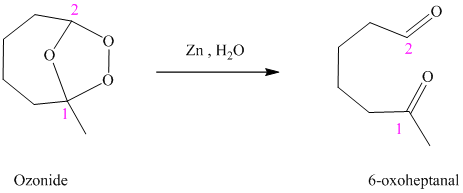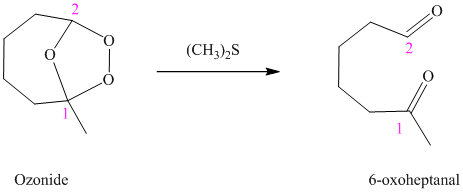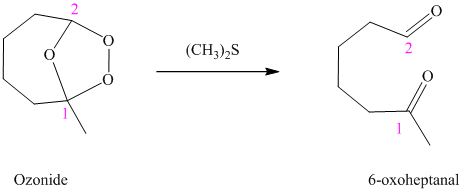
Concept explainers
Interpretation:
Structures of the major organic products formed in the reaction of
Concept introduction:
Since
According to Markovnikov’s rule. when an unsymmetrically substituted alkene reacts with a hydrogen halide, hydrogen adds to the carbon that has the greater number of hydrogen and halogen adds to the carbon that has fewer hydrogen.
In hydroboration-oxidation reaction, hydrogen atom gets bonded to the carbon that has fewer hydrogen and the hydroxyl to the carbon that has the greater number of hydrogen. This is a rule opposite of Markovnikov’s addition.
Answer to Problem 30P
Solution:
a)

b)

c)

d)

e)

f)
 g)
g)

h)

i)

Explanation of Solution
a) The reaction is as follows:

The given alkene
According to Markovnikov’s rule, the hydrogen chloride gets added to the double bond of
b) The reaction is as follows:

This reaction is an acid catalyzed electrophilic addition reaction of alkenes. In this reaction, water molecule gets added to the double bond in
In this reaction, the addition of water molecule to alkene follows Markovnikov’s rule. The hydrogen atom in water molecule adds to the carbon
The addition mechanism for this reaction follows Markovnikov’s rule, and so the major organic product for the above acid-catalyzed electrophilic addition reaction is
c) The reaction is as follows:

This reaction is the hydroboration-oxidation reaction of alkenes. In this reaction, water molecule gets added to the double bond in
The hydrogen atom from water molecule adds to the carbon
Thus, when
d) The reaction is as follows:
Bromine reacts rapidly with alkenes by electrophilic addition. The products are called vicinal dibromides, meaning that the bromine atoms are attached to adjacent carbon atoms in the double bond. It is carried out in suitable solvents such as
Bromine adds across the double bond in

e) The reaction is as follows:

In aqueous solution, chlorine and bromine react with alkenes to give corresponding vicinal halohydrins. Halohydrin compounds have a halogen and hydroxyl group on adjacent carbon atoms. In alkene, halogen atom bonds to that carbon atom which has a larger number of hydrogen and hydroxyl group bonds to that carbon atom which has a smaller number of hydrogen.
In the reaction of
f) The reaction is as follows:

Peroxyacids transfers oxygen to the double bond of an alkene to yield epoxides. An epoxide is a three-membered oxygen-containing ring.
When
g) The reaction is as follows:

Ozone is a powerful electrophile and reacts with alkenes to cleave the double bond, forming an ozonide.
h) The reaction is as follows:

Ozonides are formed as a result of the reaction of ozone with an alkene. Ozonides undergo hydrolysis in water, giving carbonyl compounds. According to the structure of the starting alkene, various carbonyl products are formed such as formaldehyde, aldehydes, or ketones.
When the corresponding ozonide of
i) The reaction is as follows:

Ozonides are formed as a result of the reaction of ozone with an alkene. Ozonides undergo hydrolysis in water, giving carbonyl compounds. According to the structure of the starting alkene, various carbonyl products are formed such as formaldehyde, aldehydes, or ketones.
When corresponding ozonide of
Want to see more full solutions like this?
Chapter 8 Solutions
Organic Chemistry - Standalone book
- An aromatic compound ‘A’ on treatment with aqueous ammonia and heating forms compound ‘B’ which on heating with Br2 and KOH forms a compound ‘C’ of molecular formula C6H7N. Write the structures and IUPAC names of compounds A, B and C.arrow_forwardAn optically active monoterpene (compound A) with molecular formula C10H18O undergoes catalytic hydrogenation to form an optically inactive compound with molecular formula C10H20O (compound B). When compound B is heated with acid, followed by reaction with O3 and then with dimethyl sulfide, one of the products obtained is 4-methylcyclohexanone. Give possible structures for compounds A and B.arrow_forwardProvide the structure of the major organic product of the following reaction and? explain the stereochemistry which results in this product. 2-Pentanol reacting with 1.) PBr3, pyridine 2.) NaCNarrow_forward
- Wolff-Kishner reduction of compound W gave compound A. Treatment of A with m-chloroperbenzoic acid gave B which on reduction with LiAH4 gave C. Oxidation of compound C with chromic acid gave D (C9H14O). Suggest the structures for A, B, C, and D.arrow_forwardExplain the Mechanism - Addition of Dichlorocarbene to an Alkene ?arrow_forwardGive the series of reactions below, identify and give the iupac name for the following compounds, in short identify and name A,B,Carrow_forward
- Compound F may be synthesised by the method attached: When 2-chloropropane treated with NaOH and 1-chloropropane treated with NaOH separately produce two different functional groups. Provide both reactions and explain the two different functional groups produced.arrow_forwardCompound A (C6H12O2) reacts with water, acid, and heatto yield compound B (C5H10O2) and compound C (CH4O).Compound B is acidic. Deduce possible structures of compounds A, B, and Carrow_forwardA hydrocarbon (X), with the molecular formula: C8H14 is reduced in presence of sodium and liquid ammonia to give the only product (Y) with the molecular formula: C8H16. Compounds X and Y both resulting 2,5-dimethylhexane when treated with hydrogen and platinum catalyst (H2/Pt). As a result of the oxidative cleavage of compound Y (by using KMnO4 / H2SO4), a single carboxylic acid derivative with C4H8O2 molecular formula is formed. Again, as a result of the reaction of Y with perbenzoic acid, the chiral compound C8H14O is observed, but the reaction of compound Y with bromine gives the achiral C8H14Br2 as the product.arrow_forward
- Two isomers, A and B, of molecular formula C5H8 undergo catalytic hydrogenation with hydrogen gas and palladium on carbon to form the same C5H10 product. On ozonolysis followed by treatment with hydrogen peroxide (H2O2), isomer A gave a product of molecular formula C5H8O4 that has two carboxylic acid groups in it whereas isomer B gave a product of molecular formula C5H8O3 that contains a carboxylic acid group and a ketone group. Which of the following isomeric pairs best match this data?arrow_forwardTwo isomers, A and B, of molecular formula C5H8 undergo catalytic hydrogenation with hydrogen gas and palladium on carbon to form the same C5H10 product. On ozonolysis followed by treatment with hydrogen peroxide (H2O2), isomer A gave a product of molecular formula C5H8O4 that has two carboxylic acid groups in it whereas isomer B gave a product of molecular formula C5H8O3 that contains a carboxylic acid group and a ketone group. What is the isometric pair of A and B that corresponds?arrow_forward3. Obtain acetophenone and acetaldehyde by reaction of glycols with periodic acid. Justify your answer with the reaction mechanism.arrow_forward
 ChemistryChemistryISBN:9781305957404Author:Steven S. Zumdahl, Susan A. Zumdahl, Donald J. DeCostePublisher:Cengage Learning
ChemistryChemistryISBN:9781305957404Author:Steven S. Zumdahl, Susan A. Zumdahl, Donald J. DeCostePublisher:Cengage Learning ChemistryChemistryISBN:9781259911156Author:Raymond Chang Dr., Jason Overby ProfessorPublisher:McGraw-Hill Education
ChemistryChemistryISBN:9781259911156Author:Raymond Chang Dr., Jason Overby ProfessorPublisher:McGraw-Hill Education Principles of Instrumental AnalysisChemistryISBN:9781305577213Author:Douglas A. Skoog, F. James Holler, Stanley R. CrouchPublisher:Cengage Learning
Principles of Instrumental AnalysisChemistryISBN:9781305577213Author:Douglas A. Skoog, F. James Holler, Stanley R. CrouchPublisher:Cengage Learning Organic ChemistryChemistryISBN:9780078021558Author:Janice Gorzynski Smith Dr.Publisher:McGraw-Hill Education
Organic ChemistryChemistryISBN:9780078021558Author:Janice Gorzynski Smith Dr.Publisher:McGraw-Hill Education Chemistry: Principles and ReactionsChemistryISBN:9781305079373Author:William L. Masterton, Cecile N. HurleyPublisher:Cengage Learning
Chemistry: Principles and ReactionsChemistryISBN:9781305079373Author:William L. Masterton, Cecile N. HurleyPublisher:Cengage Learning Elementary Principles of Chemical Processes, Bind...ChemistryISBN:9781118431221Author:Richard M. Felder, Ronald W. Rousseau, Lisa G. BullardPublisher:WILEY
Elementary Principles of Chemical Processes, Bind...ChemistryISBN:9781118431221Author:Richard M. Felder, Ronald W. Rousseau, Lisa G. BullardPublisher:WILEY





